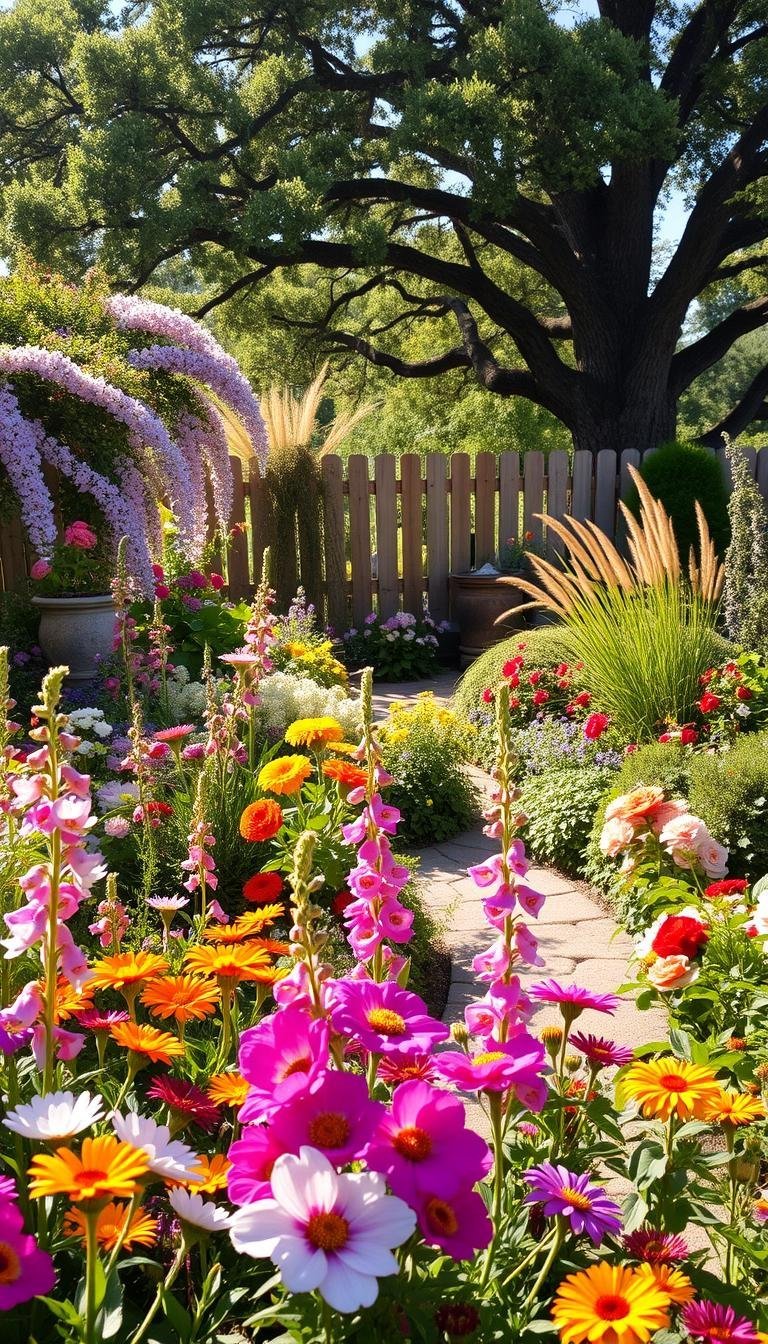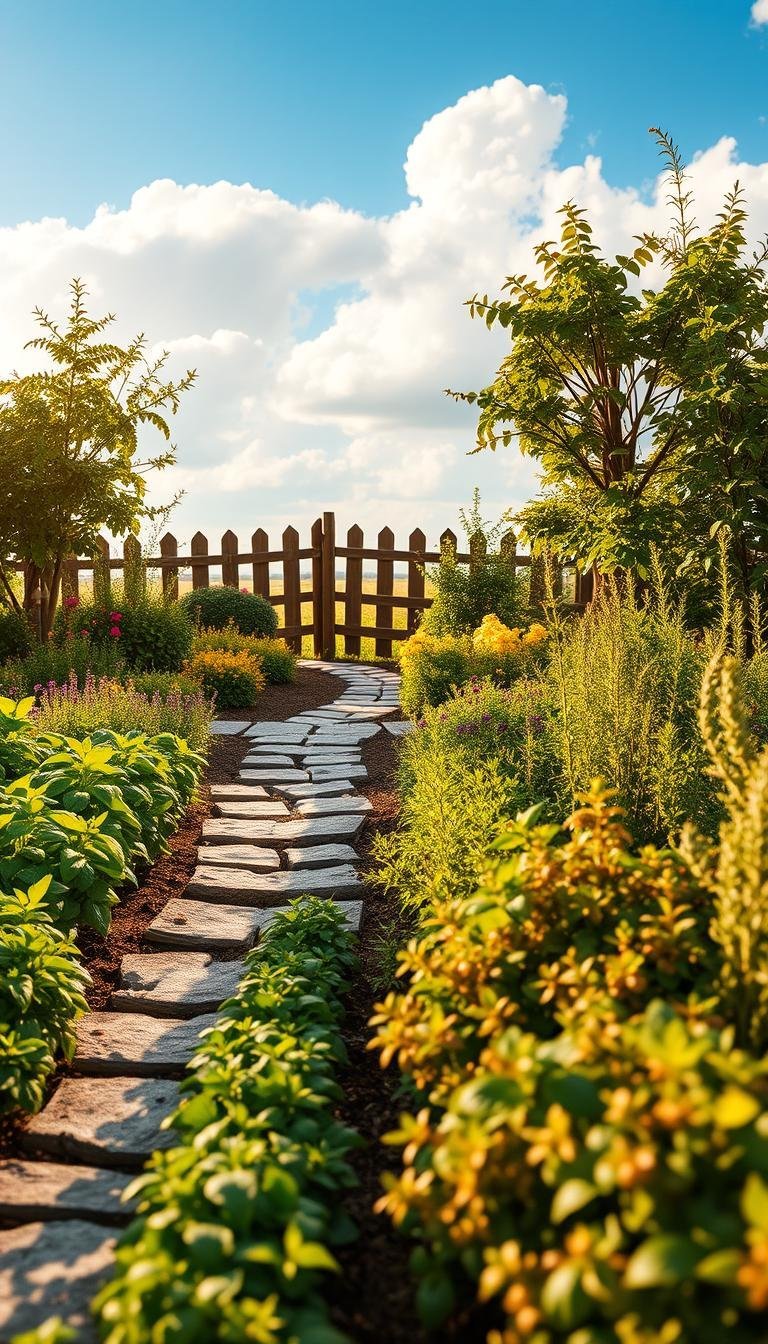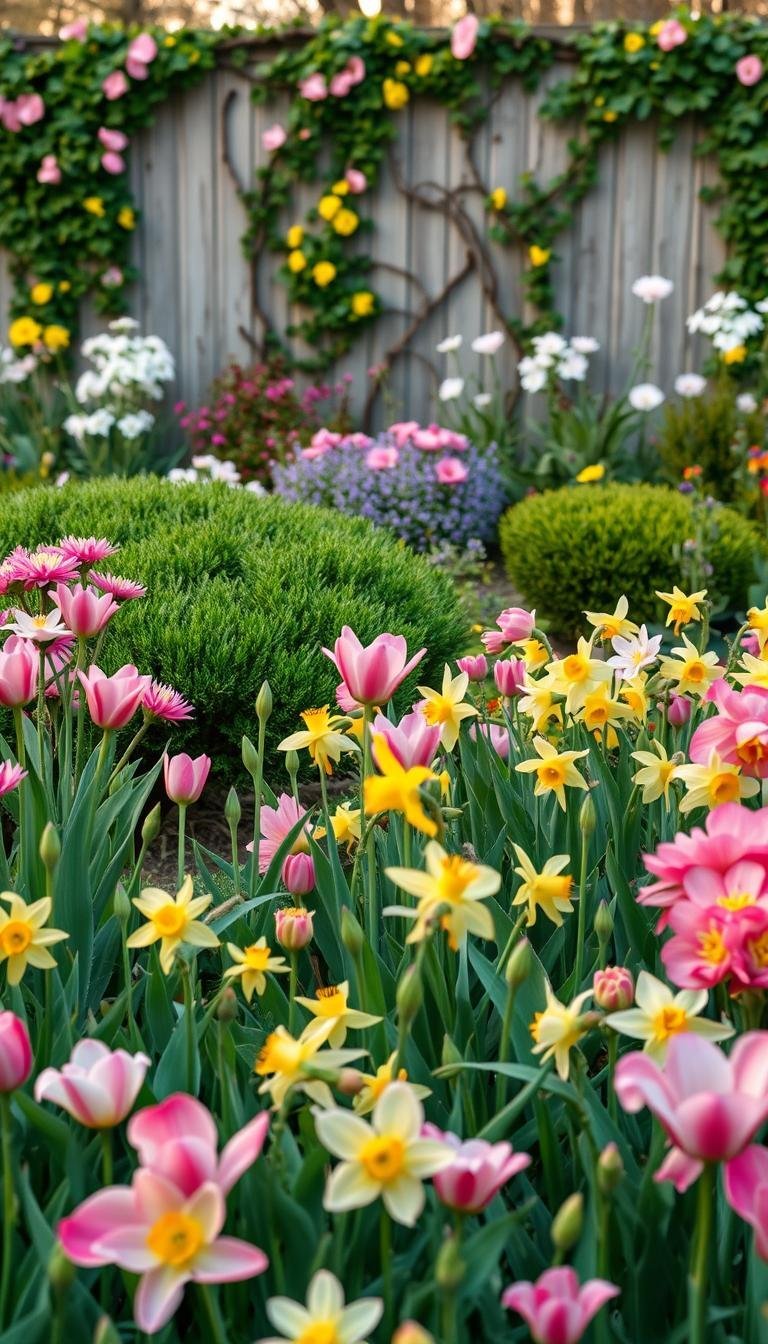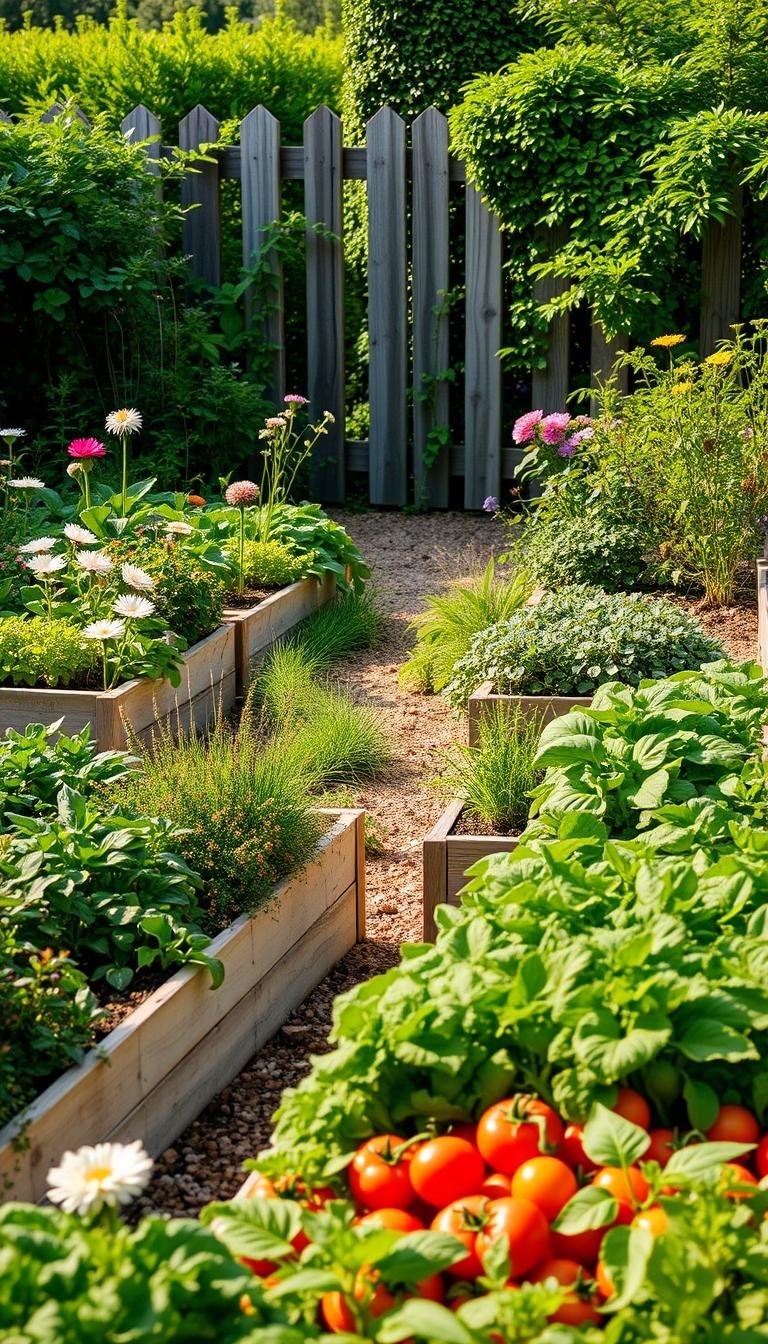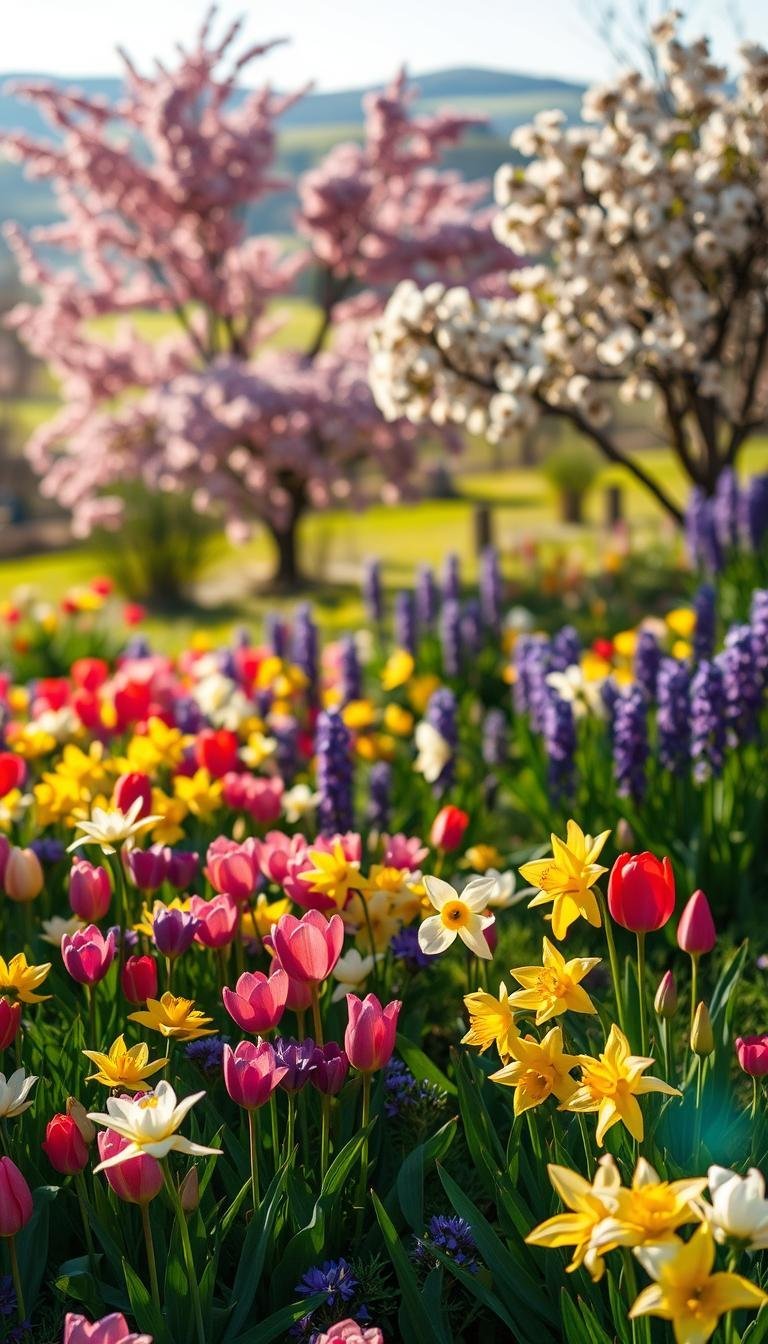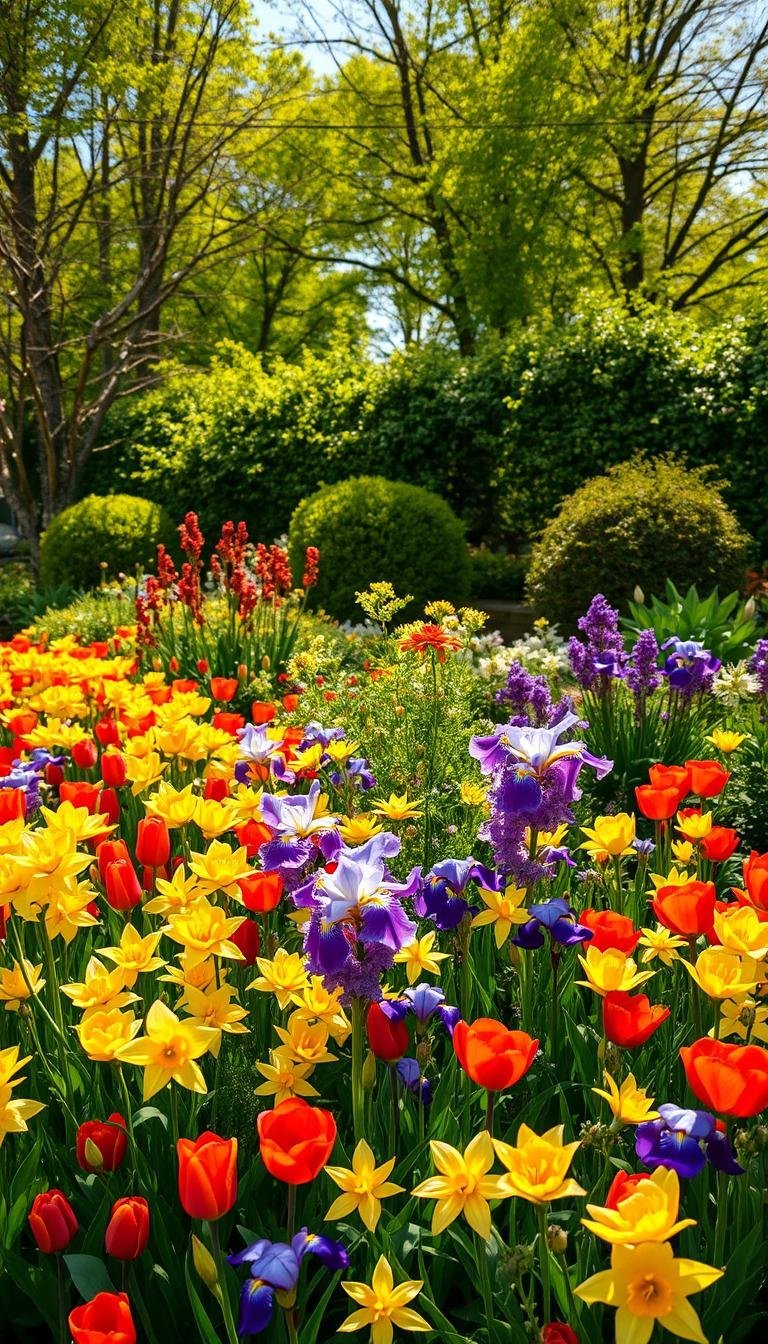This post may contain affiliate links. If you click and buy, we may earn a small commission at no extra cost to you. Learn more.
Cottage Garden Flowers are a symbol of rustic beauty. They mix history and nature, making spaces feel alive. These flowers do well in relaxed, layered designs, unlike stiff, formal ones.
Whether your garden is small or big, cottage gardens are welcoming. They’re a style that everyone can enjoy.
Picture a garden where flowers spill over borders, welcoming butterflies and sunlight. Cottage Garden Flowers make this magic happen with their easy yet thoughtful design.
This guide will show you how to turn any space into a lively, charming oasis. It will be filled with timeless beauty.
Contents
- 1 What is a Cottage Garden Flower?
- 2 Benefits of Cottage Gardens
- 3 Designing Your Cottage Garden
- 4 Best Cottage Garden Flowers for Beginners
- 5 Year-Round Cottage Garden Themes
- 6 Companion Planting in Cottage Gardens
- 7 Caring for Cottage Garden Flowers
- 8 Attracting Pollinators to Your Cottage Garden
- 9 Incorporating Herbs into Your Cottage Garden
- 10 Creating a Sustainable Cottage Garden
- 11 Showcasing Your Cottage Garden
What is a Cottage Garden Flower?
Traditional garden flowers are found in spaces that look like English countryside cottages. These plants grew in small gardens where beauty and usefulness went hand in hand. English cottage garden plants are tough and don’t need much care, showing a timeless beauty.

Characteristics of Cottage Garden Flowers
These plants have special traits that make them appealing:
- Informal growth habits that blend naturally into surroundings
- Abundant blooms in soft pastels or bold hues
- Sweet fragrances that fill outdoor spaces
- Self-seeding tendencies to spread effortlessly
Popular Varieties
Classic choices for cottage gardens include:
- Roses: Climbing or shrub varieties add structure and scent
- Hollyhocks: Towering spikes of ruffled blossoms
- Foxgloves: Spiky blooms in vivid colors
- Lavender: Fragrant evergreen foliage and purple spikes
- Delphiniums: Tall plumes perfect for back borders
These English cottage garden plants have lasted for generations. They do well in mixed plantings, adding color and texture without needing strict symmetry. Their easy nature makes them perfect for gardeners who want beauty without daily upkeep.
Benefits of Cottage Gardens
Cottage gardens are not just beautiful; they also serve a purpose. They mix beauty with function, making them perfect for any outdoor space. Let’s explore why they’re a great choice for both looks and usefulness.
Aesthetic Appeal

They turn yards into living art. Lavender and cosmos add softness, while wild roses and sunflowers bring vibrant colors.
The garden’s unplanned layout invites you to explore. Every corner seems to tell a story.
Wildlife Attraction
These gardens are a feast for wildlife. Rustic garden blooms like echinacea feed bees, while marigolds attract birds. Plant clusters become homes for many species.
Adding a birdbath or pond makes it even better. Your garden becomes a thriving ecosystem.
Low Maintenance Options
Don’t have time for gardening? Cottage gardens are easy to care for. Choose plants like coneflowers or yarrow—whimsical garden flowers that need little care.
Mulch and compost replace harsh chemicals. They keep the soil healthy without daily work. Once they’re set, these plants bloom beautifully, saving you time.
Designing Your Cottage Garden
Make your space beautiful with cottage garden flowers that never go out of style. Choose a spot where these flowers can grow well. Sunlight, soil, and space are important for a lively garden.
Choosing the Right Location
Find a place that gets 6+ hours of sunlight each day. Check the soil’s pH and add compost if it’s off. Even small areas can have a cottage garden. Use trellises to make the most of your space.
Color Schemes and Flower Combinations
Classic cottage gardens use soft colors like pinks, whites, and blues. Pair lavender with hydrangeas for a beautiful layered effect. Peonies and sweet peas look great together. But, use bold colors carefully to keep the garden’s natural beauty.
Incorporating Hardscapes
- Picket fences add structure while keeping the space open.
- Arbors frame pathways and support climbing roses or clematis.
- Stone paths meander through plantings, guiding visitors through the garden.
Use containers with vintage garden blooms to add color near where you sit. Mix materials like weathered wood and natural stone. This adds to the garden’s rustic charm without overpowering the flowers.
Best Cottage Garden Flowers for Beginners
Cottage gardens are perfect for new gardeners! Many Cottage Garden Flowers are easy to care for. They’re great for beginners. Start small and watch your garden grow with confidence. Here’s how to choose plants that are strong and beautiful.

Easy-to-Grow Options
- Cosmos: Sow seeds in spring soil. They bloom all summer with just water and sunlight.
- Nasturtiums: Plant these peppery-flavored blooms in pots or beds—they deter pests and attract bees.
- Cornflowers: Hardy and drought-tolerant, they add blue pops to any Cottage style garden plants mix.
- Hardy Geraniums: These pink and purple perennials return yearly, needing only occasional weeding.
Seasonal Favorites
Choose plants that bloom in waves for year-round color:
- Spring: Peonies and sweet peas create lush early-season displays.
- Summer: Sunflowers and lavender bring height and fragrance.
- Fall: Mums and goldenrod shine in autumn hues.
- Winter: Evergreens like boxwood keep structure through frost.
“Success starts with plants that forgive mistakes. Let your garden evolve at its own pace.”
Begin with a few reliable varieties, then expand as you gain experience. Even a small patch of Cottage Garden Flowers can create that cozy, timeless look. Let nature guide your choices—one bloom at a time!
Year-Round Cottage Garden Themes
Turn your garden into a year-round showstopper with traditional flowers and charming varieties. Plan carefully to make each season a new chapter of beauty. Learn how to keep your garden beautiful all year.

Spring Blooms
Spring brings daffodils and tulips bursting through the frost. Add bleeding hearts and forget-me-nots for a mix of soft pinks and blues. These early flowers mark the start of your garden’s cycle.
Summer Spectacles
Summer peaks with roses and delphiniums, the heart of cottage gardens. Mix hollyhocks and daisies for height and color. Peonies add dramatic texture to this lively season.
Autumn Wonders
Autumn brings asters and sedum in golds and russets. Japanese anemones and ornamental grasses add to the season’s beauty. These plants make autumn a feast for the eyes.
Winter Essentials
Winter’s beauty comes from evergreens and berries. Hellebores bloom in soft colors, while hydrangea skeletons and winter jasmine add structure. These keep your garden alive in winter.
Combining traditional flowers with seasonal picks keeps your garden interesting all year. A well-planned mix of blooms and foliage turns your space into a four-season wonderland.
Companion Planting in Cottage Gardens
Cottage gardens are all about nature’s teamwork. Companion planting uses these partnerships to make plants healthier and keep pests away. By carefully choosing which English cottage garden plants to grow together, gardeners create a balanced and beautiful space.
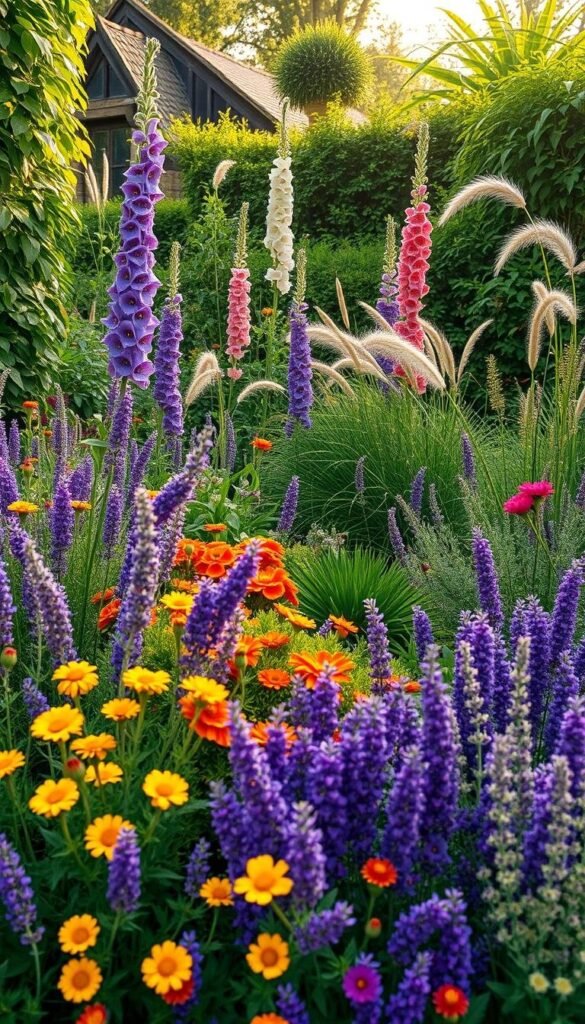
Enhancing Growth and Health
Some plants work together like a team. For example, rose and garlic are a great pair. Garlic keeps pests away, and roses add height. The “Three Sisters” method—corn, beans, and squash—also shows how plants can help each other.
These partnerships make the soil better and cut down on the need for chemicals.
- Tomatoes + basil: Improves growth and flavor
- Nasturtiums + cabbage: Deters caterpillars
Pest Control Benefits
Plants have their own defense systems. Strong-smelling whimsical garden flowers like marigolds confuse pests. Dill attracts ladybugs, which eat aphids. Radishes can even act as a trap crop to protect lettuce.
“A garden unplanned is a garden unloved.” – Cottage gardening proverb
Historic cottage gardens used these methods before pesticides were invented. Today, they offer a way to grow beautiful, healthy gardens without chemicals. Mixing herbs like thyme with lavender not only repels moths but also adds a lovely scent.
Caring for Cottage Garden Flowers
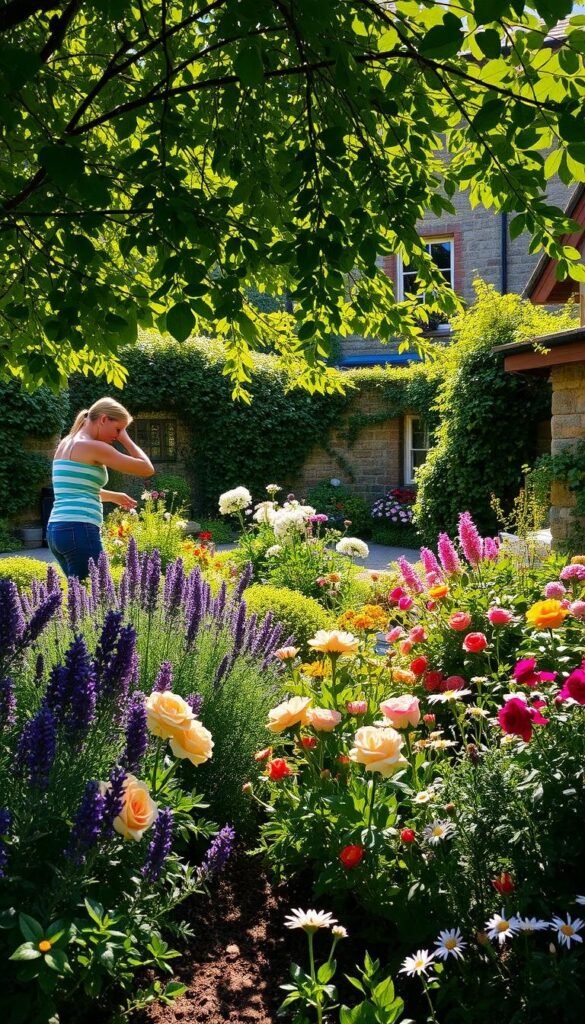
Keeping cottage gardens looking good doesn’t need to be hard. Just use smart tips to keep your plants healthy and your garden looking rustic.
Watering and Fertilization
Water your cottage plants deeply once a week, more often if it’s dry. Don’t water them every day, as this can make their roots shallow. For new plants, water well when you plant them and use mulch to keep the soil moist.
Use organic fertilizers like compost tea or bone meal in the spring. But be careful not to overfeed, as this can harm your plants. Always follow the instructions on the fertilizer package.
Pruning Techniques
Remove dead flowers from plants like roses and delphiniums to make them bloom longer. Cut back overgrown perennials in late fall to stop diseases. Prune woody plants like hydrangeas in late winter to control their shape.
Always clean your pruning tools between cuts to stop diseases from spreading.
Seasonal Clean-Up
- Spring: Clear out old debris but leave some dried seed heads for birds. Also, divide any crowded perennials.
- Summer: Remove dead leaves but don’t do too much pruning when it’s hot.
- Fall: Cut back any tender plants after the first frost. Leave strong stems like coneflowers for winter interest.
- Winter: Check for diseased wood and prune if needed. But don’t overdo it to keep wildlife happy.
By giving a little care each season, your rustic garden will stay beautiful and natural. Focus on keeping your plants healthy without losing that cozy cottage look.
Attracting Pollinators to Your Cottage Garden
Cottage gardens are alive with both plants and animals. By choosing Cottage Garden Flowers and Vintage garden blooms, you welcome bees, butterflies, and more. These visitors help keep your garden healthy and support the environment.
Importance of Bees and Butterflies
Bees and butterflies carry pollen between plants. This is key for fruit, seeds, and future blooms. Without them, our food and wild places could suffer. Cottage gardens offer a safe haven with their diverse plants.
Best Flowers for Pollinator Attraction
For pollinators, pick flowers that bloom all season:
- Cottage Garden Flowers like lavender and phlox offer nectar in spring.
- Vintage garden blooms such as sunflowers and zinnias shine in summer.
- Fall favorites like goldenrod and sedum feed butterflies as they migrate.
Native plants like milkweed and bee balm fit right in. Plant them in groups and choose blooms that overlap. This way, your garden becomes a vibrant, connected home for pollinators, one flower at a time.
Incorporating Herbs into Your Cottage Garden
Herbs are key in cottage gardens, adding both beauty and use. They grow well with other flowers, making the garden more interesting. This tradition goes back centuries, where every plant had a role.
Culinary Uses
Choose herbs that make your meals better and your garden prettier. Here are some great picks:
- Sage looks good with rosemary, and its silver leaves stand out against bright flowers like marigolds.
- Chives add a splash of purple when they bloom, matching well with lettuce or cosmos.
- Thyme makes a nice groundcover between taller flowers like sunflowers or peonies.
Fragrant Varieties
Herbs make your garden smell amazing. Plant them where you can enjoy their scents:
- Lavender’s purple spikes are perfect near where you sit, releasing a lovely smell when touched.
- Lemon balm’s citrusy scent goes well with flowers like daisies or phlox.
- Mint’s strong leaves add texture but need pots to stop them from spreading. Place pots near paths for easy reach.
Herbs also attract bees and butterflies, helping the garden’s ecosystem. Mix them with flowers like pansies or sweet alyssum for beauty all year. They keep old traditions alive while making modern gardens richer.
Creating a Sustainable Cottage Garden
Sustainable cottage gardens are beautiful and kind to nature. They use eco-friendly ways to grow charming floral varieties and English cottage garden plants.
Eco-Friendly Practices
- Mulch wisely: Organic mulch keeps moisture in and weeds out.
- Harvest rainwater: Rain barrels collect water for your garden.
- Plant locally: Pick English cottage garden plants that fit your area to save water.
- Encourage biodiversity: Native plants help pollinators and insects.
Organic Gardening Tips
Grow without chemicals with these tips:
- Compost from kitchen scraps and garden waste makes soil better.
- Plant cover crops like clover to stop erosion and add nutrients.
- Ladybugs and lacewings control pests without pesticides.
- Rotate crops to keep soil healthy and prevent disease.
Traditional cottage gardens were all about being self-sufficient. This idea fits today’s green goals perfectly. By picking drought-tolerant charming floral varieties and avoiding synthetic stuff, your garden is a haven and a green success.
Showcasing Your Cottage Garden
Your cottage garden is more than a place to relax—it’s a story to tell. You can share its beauty through photos or by inviting friends to explore. These ideas will help you share your garden with the world.
Photography Tips
To capture the beauty of your garden, look for details like dew on flowers or sunlight through leaves. Use wide shots to show the garden’s layers and close-ups for the flowers. For social media, add colorful photos with short captions about your favorite plants.
Smartphones are great for quick photos, but a DSLR with a macro lens can really bring out colors and textures.
Hosting Garden Tours and Events
Open your garden to the community by hosting a neighborhood day or joining local tours. Create themed paths and signs for plants like lavender or peonies. Set up cozy spots among herbs for visitors to relax.
For evening events, add fairy lights and serve lemonade. Ask guests to share their photos on social media. You could also partner with local nurseries for plant giveaways, making your garden a community spot.
To bring you cozy inspiration more efficiently, we sometimes use AI to assist in content creation — but every word and idea is carefully shaped by our team. See our AI Disclosure for more info.

